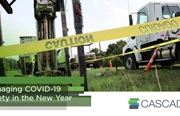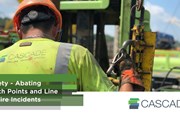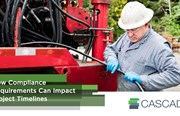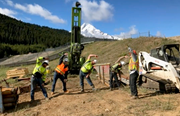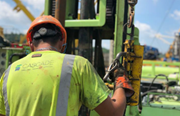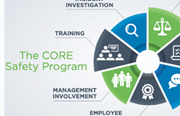Summer Safety for Outdoor Work
By: Richard BolandThe potential for heat-related illness is a well-recognized hazard in the outdoor workplace and one of Cascade’s top safety priorities. Excessive heat exposure has been linked to heat stroke, heat exhaustion, heat cramps and heat rash. Occupation injuries also rise due to fatigue, difficulty utilizing personal protective equipment (PPE) and burns from hot surfaces. The following control measures significantly reduce the risk of injury when implemented before and during work in elevated temperatures.
PREVENTION
- Implement and train employees on a written Heat Illness Prevention Program including procedures for high heat activities, engineering controls (misting fans or air conditioning), acclimatization for short service employees and an emergency plan describing response procedures in the event that a heat-related illness does occur.
- Ensure adequate supplies of cool drinking water are available, rest and shade are accessible and encourage crews to drink and rest throughout the workday.
- Modify work schedules as much as feasible to take advantage of cooler ambient temperatures.
- Designate a person to ensure compliance with the Heat Illness Prevention Program.
- Review Heat-Related Illness Standards, emergency contacts and routes, and employee fit for duty at every tailgate meeting.
- Post emergency contacts so they are visible at the job site.
Understanding Different Heat Illnesses, Symptoms, and Treatments.
- Heat Stroke - This most serious form of heat injury. It can occur if your body temperature rises to 104°F (40°C) or higher. Heatstroke requires emergency treatment. Untreated heat stroke can quickly damage your brain, heart, kidneys, and muscles. The damage worsens the longer treatment is delayed, increasing your risk of serious complications or death. Symptoms include confusion, loss of consciousness, and seizures. Workers experiencing heat stroke have a very high body temperature and may stop sweating. Contact 911 and immediately move the person into the shade or indoors, remove excess clothing and cool the person with whatever means available.
- Heat Exhaustion - Secondary to heat stroke, heat exhaustion is the next most serious form of heat injury. Symptoms of heat exhaustion include heavy sweating, fatigue, weak or rapid pulse, nausea, and headache. For treatment, stop all activity, have the employee move to a cooler place, rest and encourage sips of cool water. Monitor the employee and seek medical attention if symptoms worsen.
- Heat Cramps - Heat cramps are painful, involuntary muscle spasms. Fluid and electrolyte loss often contribute to heat cramps. Muscles most often affected include calves, arms, abdominal wall, and back. Workers with heat cramps should replace fluids loss by drinking water and electrolyte-containing sports drinks frequently after symptoms occur.
- Heat Rash - Heat rash is very common and occurs when blocked sweat ducts trap perspiration under your skin. Common areas include the neck, upper chest, skin folds, and other areas where clothing causes friction. Heat rash usually clears on its own and can be treated by cooling the skin and keeping the affected area dry.
Websites and Apps
- The Heat Index Formula chart and Heat Index calculator are available through the National Weather Service website https://www.weather.gov/safety/heat-index. Both are valuable tools in determining safe working conditions in respect to ambient air temperature combined with relative humidity
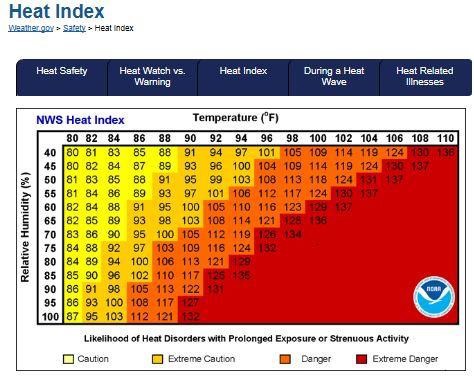
- The OSHA-NIOSH Heat Safety Tool mobile application can be added to smartphones to give workers access to data including the current and hourly heat index, signs and symptoms of heat stress illness, first aid guidance, and recommendations to protect workers based on calculated risk. The application is available both in English and Spanish.
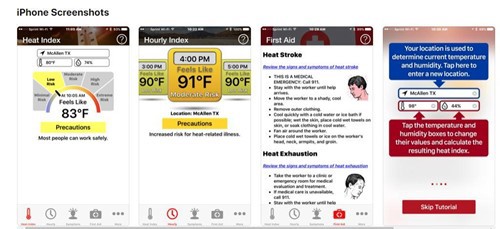
A Real Life Drilling Safety Example
A recent drilling project provided a unique situation facing some of the opportunities and challenges performing environmental drilling services in elevated temperatures in the Southwestern United States in August 2017.
Due to environmental conditions at the site, the work was performed by crews utilizing atmosphere supplied breathing air (level B) and chemical suits. With the added level of protection, the potential for heat stress was a considerable factor when planning the project. Both the client and the crew worked together to ensure the proper safety measures were in place to ensure safe completion of the project including:
- A site-specific Heat Stress Prevention Plan was developed between the client and the drilling crew.
- The work was scheduled for nights, which though temperatures exceeded 100 degrees F, allowed the crew to avoid working in direct sunlight.
- An air-conditioned tent was available and utilized by the crew for rest breaks.
- The atmosphere supplied breathing air trailer was stored in a cool area out of direct sunlight.
- A break schedule was agreed upon and mandated by both the client and drilling company.
- The OSHA-NIOSH Heat Safety Tool mobile application was downloaded to the employee’s smartphones. The app was useful for providing the approximate heat index based on local meteorological data, and also provides information about heat stress mitigation for various levels of heat-related hazards.
- Daily communication between the client and the drilling company was conducted to evaluate current work conditions and ensure the crew was in compliance with the Heat Stress Prevention Plan.
The project lasted several weeks. Cooperation and pre-planning between the client and drilling crew ensured not a single heat-related illness incident occurred.
SUMMARY
Exposure to elevated temperatures poses unique hazards to our workers during summer months. Through a dedicated safety program, training and pre-planning, heat-related injuries can be prevented.

